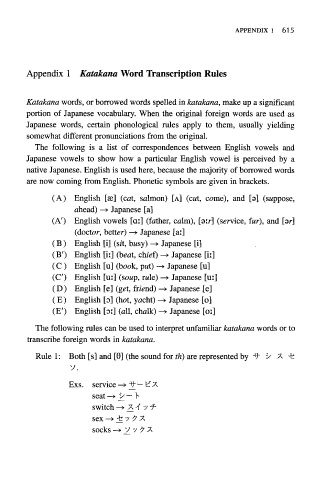Page 689 - Makino,Tsutusi.DictionaryOfIntermediateJGrammar
P. 689
APPENDIX 1 61 5
Appendix 1 Katakana Word Transcription Rules
Katakana words, or borrowed words spelled in katakana, make up a significant
portion of Japanese vocabulary. When the original foreign words are used as
Japanese words, certain phonological rules apply to them, usually yielding
somewhat different pronunciations from the original.
The following is a list of correspondences between English vowels and
Japanese vowels to show how a particular English vowel is perceived by a
native Japanese. English is used here, because the majority of borrowed words
are now coming from English. Phonetic symbols are given in brackets.
English [ae] (cat, salmon) [A] (cut, come), and [a] (suppose,
ahead) + Japanese [a]
English vowels [a:] (father, calm), [a:r] (service, fur), and [ar]
(doctor, better) + Japanese [a:]
English [i] (sit, busy) + Japanese [i]
English [i:] (beat, chief) + Japanese [i:]
English [u] (book, put) + Japanese [u]
English [u:] (soup, rule) + Japanese [u:]
English [el (get, friend) + Japanese [el
English [3] (hot, yacht) + Japanese [o]
English [z] (all, chalk) + Japanese [o:]
The following rules can be used to interpret unfamiliar katakana words or to
transcribe foreign words in katakana.
Rule 1: Both [s] and [el (the sound for th) are represented by 3f 2 K -k
Y.
Exs. service + +f - PX
seat -+ 2 - 1-
switch + 2 4 r -f
sex+sr 3X
r
socks + 2 3 X

